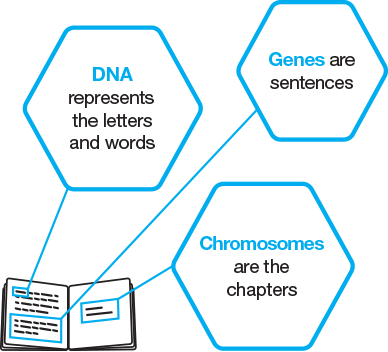Fabry is caused by genetic mutations – they are usually passed on from parent to child, but in rare cases they can be unique to the individual. 1,2
What is a mutation? 3,4
Every cell of your body is programmed to work in a particular way, for example to help with digestion, keep your heart beating, or fight infections. To do its job properly, every single cell needs a set of instructions.
DNA is "read" by the cell and provides these instructions. A gene is a section of DNA that programs one specific instruction. The genes themselves are grouped into separate units called chromosomes.
You can think of this like an instruction manual where:

Sometimes there are changes in the DNA – these are called mutations (variants). You can think of these like misspelled words – one wrong letter can completely change the meaning of the word.
CAR
CAT
How do genetic mutations lead to Fabry? 1,5
Fabry is caused by a variety of mutations in a gene called GLA, which provides the instructions to make an enzyme (a-galactosidase A).
Normally this enzyme helps break down certain sugary-fatty substances (glycosphingolipids) in the cells of our body – but the mutations mean it can’t do its job. This leads to a build-up of those substances causing the symptoms of Fabry.
You can check for Fabry by testing for Fabry mutations 5, click here to find out more >
Families share genetics, meaning they can share Fabry mutations, click here to learn more >
Is Fabry always inherited? 2,5
Fabry and its mutations are most often inherited from a parent. In rare cases it may not be inherited – the Fabry mutations may spontaneously occur and be unique to the individual – these are known as de novo mutations. However, this individual may still be able to pass the disease onto their children.
To find out more about how Fabry can be passed down in families click here >
References
1. Germain DP. Orphanet J Rare Dis 2010;5:30; 2. Desnick RJ et al. Ann Intern Med 2003;138:338–46; 3. DNA, genes, chromosomes and mutations. Genetic Alliance UK. Available at: https://www.geneticalliance.org.uk/information/learn-about-genetics/dna-genes-chromosomes-and-mutations/ (Last accessed March 2025); 4. What is a gene? Genetic Home Reference. Available at: https://ghr.nlm.nih.gov/primer/basics/gene (Last accessed March 2025); 5. Laney DA et al. J Genet Couns 2013;22:555–64